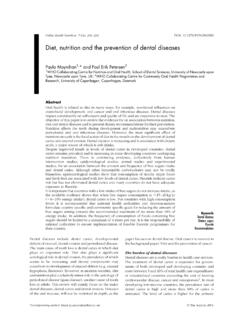Transcription of Malnutrition in Older People: calculating MUST scores ...
1 Malnutrition in Older people : calculating must scores , must we do better? D Desai 1, A Yener 1, HP Patel 1,2,3. 1 Medicine for Older people , University Hospital Southampton, Southampton UK; 2 Academic Geriatric Medicine, Faculty of Medicine, University of Southampton; 3 NIHR Southampton Biomedical Research Centre, University of Southampton & University Hospital Southampton NHS Foundation Trust, UK. Introduction Aims and Objectives The intention of this audit was to assess Malnutrition is a key contributor to both frailty compliance with this guideline across several and sarcopenia which are associated with wards specific to Medicine for Older people . multiple adverse outcomes including disability, morbidity and mortality1.
2 Malnutrition is associated with increased Method frequency of hospital admissions, longer hospital stay and greater healthcare needs in Patient records were assessed on Friday 16th the community2. December 2016 across three acute wards for This is especially important in Older patients Older people wards (84 beds). living with frailty, where nutrition may be adversely affected by other comorbidities. Of these, sixty-five records ( coverage). were reviewed to identify date of admission, The Malnutrition Universal Screening Tool presence of a must score and the time in ( must )3 (Figure 1) is a five step screening tool days between admission and calculation of to identify adults who are malnourished, at risk the score .
3 Of Malnutrition or obesity. It requires: Notes were not reviewed if the patient was Body Mass Index (BMI) assessment dying, had passed away, not present on the Degree of recent weight loss ward or if the bedside notes were not found at Effect of acute disease on nutrition the end of the bed or at the nurses station. must provides a risk score which guides the degree of intervention. The date of admission was taken as the date admitted to the current ward. Guidelines state that this score should be calculated within 24 hours of admission3. Figure 1: The must screening tool, endorsed by the British Association for Parenteral and Enteral Nutrition (BAPEN)3. Results 100% 100% 50%. 80% 40%.
4 80%. 60% 30%. 60%. 40% 20%. 40%. 20% 10%. 20% 0% 0%. 0%. G5 G6 G8. 24H 35% 52% 52%. 48H 48% 62% 62% 24h 48h Original Amended Figure 2: must score calculation within 24- Figure 3: must score calculation within 24- Figure 4: Percentage of admissions with no 48 hours of admission by ward 48 hours of admission by day of admission must score calculated by admission day Of the 65 patients assessed, 72% had a must score Patients were further assessed as a global cohort by the 18 patients had no must score , ranging from 0%. calculated during admission. 46% had this calculated within day of admission (Monday-Sunday). must assessment at (Sunday) to 46% (Monday). Data analysis was on a 24 hours (range 35-52%) and 58% had this calculated 24 hours ranged from 23% (Friday) to 88% (Tuesday).
5 Friday and included 6 patients within 24 hours of within 48 hours (range 48-62%). admission. When the analysis was amended to include those with a stay greater than 24 hours, there was a reduction in numbers on Thursday and Friday but a clear peak on Saturday (40%). Conclusions What has been learned? must there be a solution? After discussion with pharmacists and dieticians, 1. Education of all members of staff regarding There is a clear discrepancy between the extent to anecdotally there is a perceived lack of awareness of must scoring and alternative methods of which must scores are calculated across different must scoring and its role in treating Malnutrition by assessment of BMI/weight loss.
6 Wards and by differing day of admission. doctors. 2. Equipment ensure each ward area has access to However, it has been demonstrated that it is rare to Informal discussions with doctors of varying appropriate and dedicated weighing equipment. achieve a 100% assessment rate within 24 hours of grade/speciality has revealed a wide variety in admission. awareness of must and where the score can be 3. Scheduling regular review of must status of all found in patient notes. new patients could be performed on alternate days. This audit is limited by a small sample size which This would create a regular check at a point close limits the power of the analysis; however there is It is not clear to what extent abnormal must scores to 24 hours after admission for all patients and data to suggest that there is a variable degree of are translated into active management would increase awareness of patients with absent success in meeting this guideline when grouped by (documentation of dietary intake or dietician referral).
7 scores . ward or day of admission. There is a small proportion of patients who had an 4. Recording must scores could be included on Delays in detection of Malnutrition have the potential admission weight recorded on the must form but electronic lists/record systems. This may be to increase admission times and impair response to who did not have a complete must score effective at flagging up patients who require scoring intervention. documented the reasons for this are unclear. or specialist referral in a timely manner. A similar system is used to assess chest radiographs and This audit will be repeated after discussion with ECGs in acute admissions and appears to be relevant teams and implementation of agreed effective anecdotally.
8 Solutions in order to assess response. References 1) Sayer AA, Robinson SM., Patel HP., et al. New horizons in the pathogenesis, diagnosis and management of sarcopenia, Age Ageing, 2013, 42(2); 145-50. 2) Barker LA., Gout BS., Crowe TC., Hospital Malnutrition : Prevalence, Identification and Impact on Patients and the Healthcare System, Int J Environ Res Public Health, 2011, 8(2); 514-27. 3) Malnutrition Universal Screening Tool, BAPEN, Updated August 2016, Available at [Accessed 27/3/17].








